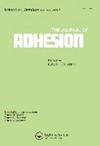粘合接头的顺应性方法:第1部分- I型应变能释放率标准化方法的研究
IF 2.3
4区 材料科学
Q2 ENGINEERING, CHEMICAL
引用次数: 3
摘要
摘要:双悬臂梁(DCB)是在模式I下获得粘合接头临界应变能释放率(GIc)的最可接受的几何形状。然而,ISO和ASTM标准推荐的标准化合规方法在估计粘合双悬臂梁合规性的准确性方面仍存在一些不确定性,因此,GIc。在这项工作中,研究了模式I下粘结接头断裂特征的标准化柔度方法,采用有限元模型获得了考虑不同裂纹长度的双悬臂梁的柔度。将有限元模型确定的柔度值与标准推荐的柔度值进行比较。得出的结论是,标准化顺应性方法对裂纹长度测量得出的问题非常敏感。修正梁理论提出的裂纹长度修正方法不充分,可能导致对结构性能和结构完整性评估的错误解释。获得双悬臂梁在裂纹长度方面的柔度的最佳方法是使用柔度校准方法,拟合实验曲线的表达式。本文章由计算机程序翻译,如有差异,请以英文原文为准。
Compliance Methods For Bonded Joints: Part I - Investigation Of The Standardized Methods To Obtain The Strain Energy Release Rate For Mode I
ABSTRACT The double cantilever beam (DCB) is the most acceptable geometry to obtain the critical strain energy release rate (GIc ) of adhesive joints under Mode I. However, there are still some areas of uncertainty in the standardized compliance methods recommended by the ISO and ASTM standards in terms of accuracy in estimating the compliance of a bonded double cantilever beam and, consequently, GIc . In this work, an investigation of the standardized compliance methods for fracture characterization of bonded joints under Mode I is conducted, employing a finite element model to obtain the compliance of a double cantilever beam, considering different crack lengths. The compliance values determined from the finite element model are compared with those recommended by the standards. It is concluded that the standardized compliance methods are very sensitive to issues derived from crack length measurements. The crack length correction methodology proposed by the corrected beam theory is inadequate, which can lead to a wrong interpretation of the structure’s behavior and the structural integrity assessment. The best approach to obtain the compliance of a double cantilever beam in respect of crack length is to use a compliance calibration method, fitting an expression for the experimental curve.
求助全文
通过发布文献求助,成功后即可免费获取论文全文。
去求助
来源期刊

Journal of Adhesion
工程技术-材料科学:综合
CiteScore
5.30
自引率
9.10%
发文量
55
审稿时长
1 months
期刊介绍:
The Journal of Adhesion is dedicated to perpetuating understanding of the phenomenon of adhesion and its practical applications. The art of adhesion is maturing into a science that requires a broad, coordinated interdisciplinary effort to help illuminate its complex nature and numerous manifestations.
 求助内容:
求助内容: 应助结果提醒方式:
应助结果提醒方式:


